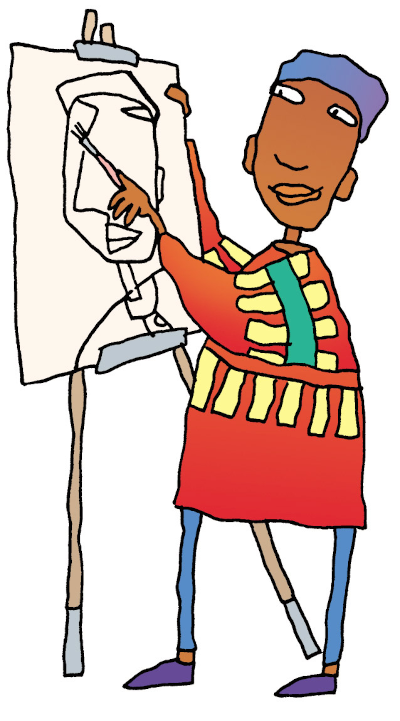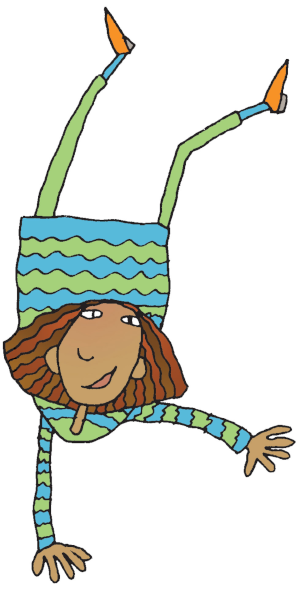Page 403
Thinking Creatively

The great painter Pablo Picasso once said, “Every child is an artist. The problem is how to remain an artist once we grow up.”
You think creatively by nature. How many times have you acted out adventures with your friends? How many times have you built forts in the living room or the woods? How many times have you made something for the simple joy of it? Creativity is fun!
So, you already think creatively. Keep that spark. Use it in every class and in all your time outside of school. Don’t let that spark go out as you grow up. The world needs creative thinkers just like you!
What’s Ahead
WE 404
Page 404
Becoming a Creative Thinker
You already are creative, but you can go further. Are artists and actors creative? Yes. But so are doctors and lawyers and politicians and engineers.
Creative thinking will . . .
- Show you new possibilities that no one else imagined
- Help you connect ideas in exciting ways
- Let you solve problems both big and small
- Make you a more interesting and funny person
- Give you a secret superpower that you carry with you everywhere
Bringing out your creativity . . .
Creativity reaches out to grab new ideas. It is optimistic. Instead of asking “Why?” it asks “Why not?” Awaken the creativity inside you:
1. Open yourself.
Think new thoughts, try new things, meet new people, look for connections. See possibilities.
2. Be curious.
Play with ideas. Wonder about your world. When you see something beautiful, ask yourself what makes it beautiful.
3. Ask questions.
Questions open up the space for ideas. What if? Why not? Could? Would? Should? How?
4. Talk to others.
Tune your brain to the best brains around you.
5. Sense the present.
Soak in sights, sounds, smells, textures, and tastes. The world is speaking to you.
6. Express yourself.
Turn those sensations into pictures, music, and food. That’s you speaking to the world.
7. Imagine the future.
What bad events could we prevent now? What good futures could we bring into being? How?
Tune your brain to the best brains around you.
Soak in sights, sounds, smells, textures, and tastes. The world is speaking to you.
Turn those sensations into pictures, music, and food. That’s you speaking to the world.
What bad events could we prevent now? What good futures could we bring into being? How?
WE 405
Page 405
Strategies for Creative Thinking
Creative thinking is about discovering. It involves playing with ideas in order to make new ones. So how do you do that? Here are some specific strategies, guaranteed to improve your creative thinking skills.
- Picture things in your mind. Visualize what might be.
- Draw, doodle, and cluster. Bring your drawings to life.
- Come up with as many ideas as you can, even silly ones.
- Bounce ideas off other people, and let them bounce back.
- What object, place, word, or sport is this subject like?
- What would happen if . . . ?
- What is the exact opposite of this?
- How could the problem actually become the solution?
- If someone says, “You can’t—” think, “But what if I did . . . ?”
- If someone says, “That’s impossible—” think, “What would make it possible . . . ?”
- Write freely, quickly, and without stopping.
- Write until you discover something that is beyond your imagination!
1. Think visually.
2. Brainstorm.
3. Use off-beat questions.

4. Use reverse thinking.
5. Challenge boundaries.
6. Write about it.
WE 406
Page 406
The Creative Mind in Action
If you’re not thinking creatively, you might look at an object like a pencil and think, “There’s a pencil. Something to write with. It’s yellow. It looks brand new.” But if you look at the same pencil with a creative mind, you’ll see something completely different.
The No. 2 Pencil Meets a Creative Mind
- First, imagine the life of the pencil—how it was made—the wood, the glue, the “lead,” the paint.
- Then, think of the tree the wood came from. Where did it grow? Where are the other parts of the tree now?
- Think about who else will use this pencil before it’s worn out. What will be the most important thing it has ever written? The funniest thing?
- Look really closely at the pencil. What else does it look like? What does it feel like?
- Suppose it is being used as a pointer. Who is pointing it, and what is the person pointing at? Why?
- Imagine the pencil as a pillar. What is it holding up?
- How strong is it? How much weight would be needed to break it?
- Imagine an occasion when this pencil might be given as a gift. What is the occasion, and why is it being given?
- Imagine a world in which no pencils (or pens) exist. What would that world be like?
Express Yourself
Can you think of other ways of looking at a pencil? Make a list and share with it with a classmate. Remember, to be a creative thinker, you always want to think of new ways of looking at old objects and ideas. You want to see Velcro, not sandburs.
WE 407
Page 407
Assessing Your Creative Thinking
Use the statements below to rate how much you use your creative thinking skills. In your mind, answer each statement with Always, Usually, Sometimes, or Never.
I enjoy using my imagination.
I enjoy brainstorming with others.
I am able to visualize a problem or solution in my mind.
I keep a journal and write down or draw my creative ideas.
I ask “What if . . . ?” when I’m thinking.
I can think quickly and add new ideas in a discussion.
I try to imagine what life is like for other people.
I recognize the creative people around me, and I watch what they do and how they do it.
I listen carefully to the ideas of others.
I make connections between things I know and things I wonder about.
I enjoy explaining things to other people.
I use thinking strategies to improve my creativity.
How did you do? If you had some Always and Usually answers, good for you. If not, try using those strategies!
Tip As Albert Einstein once said, “Imagination is everything. It is the preview of life’s coming attractions.”
Teacher Support:
Click to find out more about this resource.
© 2025 Thoughtful Learning. Copying is permitted.
k12.thoughtfullearning.com